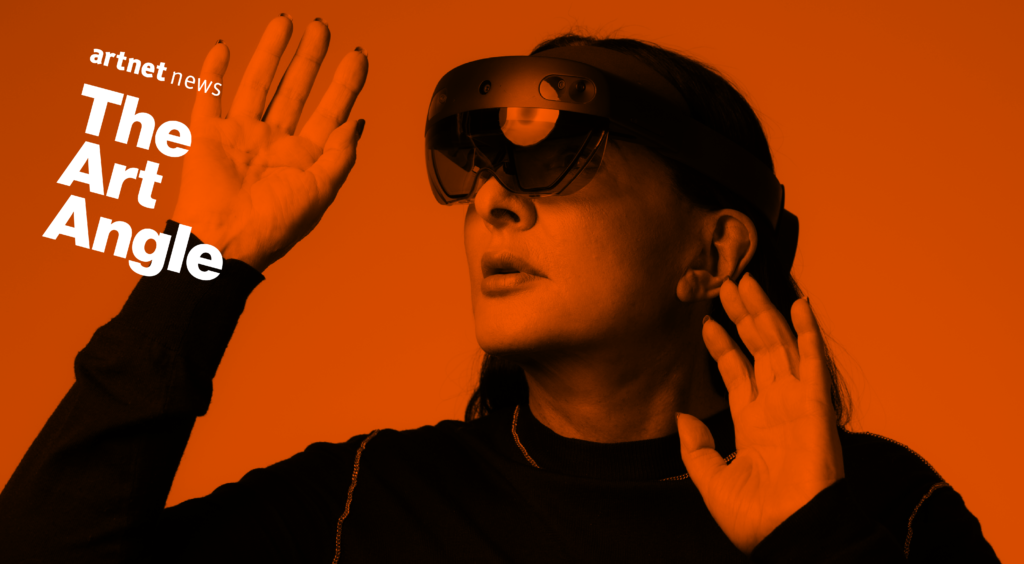The Art Angle
The Art Angle Podcast: How Marina Abramović Became the Center of a Vast Satanic Conspiracy Theory
On this week's episode, art critic Ben Davis explains why the contemporary art world is a prime target for conspiracy theories.

On this week's episode, art critic Ben Davis explains why the contemporary art world is a prime target for conspiracy theories.

Welcome to the Art Angle, a podcast from Artnet News that delves into the places where the art world meets the real world, bringing each week’s biggest story down to earth. Join host Andrew Goldstein every week for an in-depth look at what matters most in museums, the art market, and much more with input from our own writers and editors as well as artists, curators, and other top experts in the field.
Just when you thought the spring of 2020 couldn’t get any weirder, a Microsoft ad starring performance artist Marina Abramović caught the attention of conspiracy peddler Alex Jones and his followers, sparking accusations that the artist was practicing satanism and reigniting the “pizzagate” controversy that ensnared Hillary Clinton and her campaign chairman John Podesta four years ago.
It all began with a seemingly innocuous commercial put out by Microsoft to advertise a product called HoloLens 2, a newfangled set of mixed-reality smart glasses, which Abramović used to create her augmented-reality artwork The Life. Hours after the ad debuted online, an onslaught of exceedingly negative comments drove the tech company to scrub it from the Internet completely.
Abramović, a native Serbian artist who has come to define a certain brand of physically and psychologically exhaustive performance, helped chart a new path for contemporary art over the course of her 50-year career. In the process, she’s become a fashion icon and a friend and muse of such celebrities as James Franco and Lady Gaga. But, as it turns out, a certain corner of the Internet has also seized on her early work engaged with Eastern European politics and religious traditions—which involved dousing herself in gasoline inside a flaming pentagram and spending hours scrubbing blood off animal bones—as a sign that she, well, worships Satan and is the high priestess of a cabal formed by the Hollywood and political elite.
Confused? So were we. On this week’s episode of the Art Angle, Artnet News’s chief art critic Ben Davis joins host Andrew Goldstein by phone to break down the controversy—and explain why this moment of turmoil is proving to be an exceptionally fertile one for conspiracy theorists to reach an audience.
Listen above and subscribe to the Art Angle on Apple Podcasts, Spotify, SoundCloud, or wherever you get your podcasts. (Or catch up on past episodes here on Artnet News.)
Listen to Other Episodes:
The Art Angle Podcast: Ai Weiwei on the Coronavirus, China, and Art’s New Role
The Art Angle Podcast: How Photography Is Being Revolutionized in the Coronavirus Era
The Art Angle Podcast: Why Germany’s COVID-19 Relief Plan Is the Envy of the Art World
The Art Angle Podcast: The Unbelievable True Story of the Mystical Painter Agnes Pelton
The Art Angle Podcast: Three Ways Coronavirus Will Transform the Art World
The Art Angle Podcast: Why Art and Fashion Need Each Other Now
The Art Angle Podcast: What Does an Art Scene Look Like Under the Coronavirus?
The Art Angle Podcast: How an Art-Dealing Prodigy Became the market’s Most Wanted Outlaw
The Art Angle Podcast: Is the Museum of Ice Cream the Future of Art, or Just a Sugar Rush?